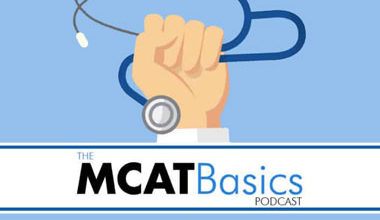The MCAT Basics Podcast with Sam Smith of MedSchoolCoach covers many topics on the AAMC MCAT. Each podcast covers a different topic, and up to 3 of the 4 MCAT sections. Lesson topics are based on the practice material, including practice tests, question banks.
The human digestive system consists of the gastrointestinal tract plus the accessory organs of digestion (the tongue, salivary glands, pancreas, liver, and gallbladder). Digestion involves the breakdown of food into smaller and smaller components, until they can be absorbed and assimilated into the body. Digestion works by moving food through the GI tract. Digestion begins in the mouth with chewing and ends in the small intestine. As food passes through the GI tract, it mixes with digestive juices, causing large molecules of food to break down into smaller molecules.
There are two kinds of digestion: mechanical and chemical. Mechanical digestion involves physically breaking the food into smaller pieces. Mechanical digestion begins in the mouth as the food is chewed. Chemical digestion involves breaking down the food into simpler nutrients that can be used by the cells. After you eat, it takes about six to eight hours for food to pass through your stomach and small intestine. Food then enters your large intestine (colon) for further digestion, absorption of water and, finally, elimination of undigested food. An adult’s digestive tract is about 30 feet (about 9 meters) long. Digestion begins in the mouth, well before food reaches the stomach. When we see, smell, taste, or even imagine a tasty meal, our salivary glands in front of the ear, under the tongue, and near the lower jaw begin making saliva (spit).
It is the organ of the human body where complete digestion of food like carbohydrates, proteins, and fats takes place. The small intestine receives the secretions of two glands that is liver and pancreas and helps in the digestion of food. Even intestinal juice also helps in the carbohydrate digestion. The small intestine has three parts. The first part is called the duodenum. The jejunum is in the middle and the ileum is at the end. The large intestine includes the appendix, cecum, colon, and rectum.
[01:39] Introduction to the show and topics today [04:23] The process of breaking down proteins to amino acids [11:34] How carbohydrates are broken down into individual monosaccharides [17:23] Regulation to eliminate waste and excess compounds from the body. [25:39] The interesting thing about kidney [31:39] Chemical digestion and then being mechanical digestion. [35:20] The way absorption occurs [39:43] Facts about the intestines [43:35] Understand how the digestive system regulates itselfQuotes:
“Large intestine is so-called the large intestine because the diameter is about three times that of the small intestine. In the large intestine is subdivided into four regions.“
Please email me if you have any comments or concerns: MCATpodcast@medschoolcoach.com
Thanks for listening!

